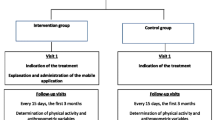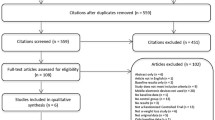Abstract
Handheld electronic devices could offer a convenient and scalable platform with which to deliver a weight loss intervention. This paper aims to summarise the evidence provided by randomised trials of such interventions. There is heterogeneity among trials in terms of the components of the intervention package, the theoretical framework, the comparison groups and the duration of follow-up. While in the short term (<6 months) trials have shown some promising findings, two trials (one of a text message intervention and one of a PDA device for dietary self-monitoring) do not indicate clinically significant weight loss in the longer term (1–2 years). Topical issues are discussed including the importance of further research into dietary self-monitoring, the logistics of trialling smartphone applications and considerations of health literacy. There is currently no definitive randomised controlled trial of a smartphone app for weight loss in adults and further research into this approach is warranted.
Similar content being viewed by others
References
Papers of particular interest, published recently, have been highlighted as: • Of importance •• Of major importance
Krishna S, Boren SA, Ballas EA. Healthcare via cell phones: a systematic review. Telemed J E Health. 2009;15:231–40.
Prabhakaren L, Chee WY, Chua KC, et al. The use of text messaging to improve asthma control: a pilot study using the mobile phone short messaging service (SMS). J Telemed Telecare. 2010;16:286–90.
Horvath T, Azman H, Kennedy GE, et al. Mobile phone text messaging for promoting adherence to antiretroviral therapy in patients with HIV infection. Cochrane Database Syst Rev. 2010;3, CD009756.
Whittaker R, Borland R, Bullen C. et al.:Mobile phone-based interventions for smoking cessation. Cochrane Database Syst Rev 2009., 14:11, CD006611.
Hurling R, Catt M, Boni MD, et al. Using internet and mobile phone technology to deliver an automated physical activity program: randomized controlled trial. J Med Internet Res. 2007;9:e7.
Spring B, Schenider K, McFadden H, et al. Multiple behavior changes in diet and activity: a randomized controlled trial using mobile technology. Arch Intern Med. 2012;172:789–96.
Sherwood NE, Morton N, Jeffery RW, et al. Consumer preferences in format and type of community-based weight control programs. Am J Health Promot. 1998;13:12–8.
Burnett KF, Taylor CB, Agras WS. Ambulatory computer-assisted therapy for obesity: a new frontier for behavior therapy. J Consult Clin Psychol. 1985;53:698–703.
Agras WS, Taylor CB, Feldman DE, et al. Developing computer-assisted therapy for the treatment of obesity. Behav Ther. 1990;21:99–109.
Taylor CB, Agras WS, Losch M, et al. Improving the effectiveness of computer-assisted weight loss. Behav Ther. 1991;22:229–36.
Burnett KF, Taylor CB, Agras WS. Ambulatory computer-assisted behavior therapy for obesity: An empirical model for examining behavioral correlates of treatment outcome. Comput Hum Behav. 1992;8:239–48.
Burke LE, Wang J, Sevick MA. Self-monitoring in weight loss: a systematic review of the literature. J Am Diet Assoc. 2011;111:92–102.
Spring B, Duncan JM, Janke E, et al. Integrating technology into standard weight loss treatment: a randomized controlled trial. JAMA Intern Med. 2013;173:105–11.
Volpp KG, John LK, Troxel AB. Financial incentive-based approaches for weight loss: a randomized trial. JAMA. 2008;300:2631–7.
John LK, Loewenstein G, Troxel AB, et al. Financial incentives for extended weight loss: a randomized, controlled trial. J Gen Intern Med. 2011;26:621–6.
Haapala I, Barengo NC, Biggs S, et al. Weight loss by mobile phone: a 1-year effectiveness study. Public Health Nutr. 2009;12:2382.
Patrick K, Raab F, Adams AM, et al. A text message–based intervention for weight loss: randomized controlled trial. J Med Internet Res. 2009;11:e1.
Turner-McGrievy G, Tate D. Tweets, apps, and pods: results of the 6-month mobile pounds off digitally (Mobile POD) randomized weight-loss intervention among adults. J Med Internet Res. 2012;13:e120. Randomised trial which uses a smartphone app alongside a Twitter and podcasting intervention. One of the first trials to use a commerically available app in a weight loss intervention. The intervention arm which used the smartphone app did not produce a statistically signifcantly greater weight loss than the intervention arm without.
Carter MC, Burley VJ, Nykjaer C, et al. Adherence to a smartphone application for weight loss compared to website and paper diary: pilot randomized controlled trial. J Med Internet Res. 2013;15:e32. Randomised pilot trial which uses a researcher developed smartphone app as a weight loss intervention. The trial found the app to be an acceptable and feasible intervention and showed promising weight loss results.
Acharya SD, Elci OU, Sereika SM, et al. Using a personal digital assistant for self-monitoring influences diet quality in comparison to a standard paper record among overweight/obese adults. J Am Diet Assoc. 2011;111:583–8.
Burke LE, Conroy MB, Sereika SM, et al. The effect of electronic self-monitoring on weight loss and dietary intake: a randomized behavioral weight loss trial. Obesity. 2011;19:338–44.
Burke LE, Styn MA, Sereika SM, et al. Using mHealth technology to enhance self-monitoring for weight loss: a randomized trial. Am J Prev Med. 2012;43:20–6. The SMART trial is a three armed RCT comparing weight loss using a PDA, PDA with feedback and paper diary. It is important given the length of it’s follow up which at 24 months is the longest trial of it’s type to date. The trial found that over the longer term there was no statistically significant difference in weight loss between different types of dietary self-monitoring.
Shapiro JR, Koro T, Doran N, et al. Text4Diet: a randomized controlled study using text messaging for weight loss behaviors. Prev Med. 2012;55:412–7. Long term randomised trial of a text message intervention for weight loss. Weight loss not found to be statistically significantly greater in the intervention arm at 1 year.
Ware JH. Interpreting incomplete data in studies of diet and weight loss. N Engl J Med. 2003;348:2136–7.
Douketis JD, Macie C, Thabane L, et al. Systematic review of long-term weight loss studies in obese adults: clinical significance and applicability to clinical practice. Int J Obes. 2005;29:1153–67.
Neve M, Morgan PJ, Jones PR, et al. Effectiveness of web-based interventions in achieving weight loss and weight loss maintenance in overweight and obese adults: a systematic review with meta-analysis. Obes Rev. 2009;11:306–21.
Eysenbach G. The law of attrition. J Med Internet Res. 2005;7:e11.
Carter MC, Burley VJ, Nykjaer C, et al. 'My Meal Mate' (MMM): validation of the diet measures captured on a smartphone application to facilitate weight loss. Br J Nutr. 2012;3:1–8.
Beasley JM, Riley WT, Davis A, et al. Evaluation of a PDA-based Dietary Assessment and Intervention Program: A Randomized Controlled Trial. J Am Coll Nutr. 2008;27:280–6.
Rennie KL, Coward A, Jebb SA. Estimating under-reporting of energy intake in dietary surveys using an individualised method. Br J Nutr. 2007;97:1169–76.
Azar KM, Lesser LI, Laing BY, et al. Mobile Applications for Weight Management: Theory-Based Content Analysis. Am J Prev Med. 2013;45:583–9.
Shaw J. Is it acceptable for people to be paid to adhere to medication? No BMJ. 2007;335:233.
Hill JO, Wing RR. The challenge of weight loss maintenance: successful losers. In: Akabas S, Lederman SA, Moore BJ, editors. Textbook of obesity: biological, psychological and cultrual influences. Malaysia: Wiley-Blackwell; 2012. p. 354–67.
Butryn ML, Webb V, Wadden TA. Behavioural treatment of obesity. Pyschiatr Clin North Am. 2011;34(4):841–59.
National Obesity Observatory: Trends in obesity prevalence. Available at http://www.noo.org.uk/NOO_about_obesity/trends. Accessed Feb 2013.
OFCOM. 2012. The Communications Market (July). Available at http://stakeholders.ofcom.org.uk/binaries/research/cmr/cmr12/CMR_UK_2012.pdf. Accessed Feb 2013
Rahmati A,Tossell C, Shepard C, et al.:Explorinng iPhone usage: The influence of socioeconomic differences on smartphone adoption, usage and usability. Proceedings of the 14th international conference on human-computer interaction with mobile devices and services 2012. pp.11-20.
Huizinga MM, Carlisle AJ, Cavanaugh KL, et al. Literacy, numeracy, and portion-size estimation skills. Am J Prev Med. 2009;36:324–8.
Rothman RL, Housam R, Weiss H, et al. Patient understanding of food labels: the role of literacy and numeracy. Am J Prev Med. 2006;31:391–8.
Zarcadoolas C, Sealy Y, Levy J, et al. Health literacy at work to address overweight and obesity in adults: The development of the obesity action kit. J Commun Healthcare. 2011;4:88–101.
Acknowledgments
J. E Cade receives grant support from National Prevention Research Initiative (NPRI) to develop and validate a smartphone weight loss app; we are exploring the potential for use of our smartphone weight loss app in the UK National Health Service.
Compliance with Ethics Guidelines
ᅟ
Conflict of Interest
Michelle C. Carter, V. J Burley, and J. E Cade declare that they have no conflict of interest.
Human and Animal Rights and Informed Consent
This article does not contain any studies with human or animal subjects performed by any of the authors.
Author information
Authors and Affiliations
Corresponding author
Rights and permissions
About this article
Cite this article
Carter, M.C., Burley, V.J. & Cade, J.E. Handheld Electronic Technology for Weight Loss in Overweight/Obese Adults. Curr Obes Rep 3, 307–315 (2014). https://doi.org/10.1007/s13679-014-0112-0
Published:
Issue Date:
DOI: https://doi.org/10.1007/s13679-014-0112-0




